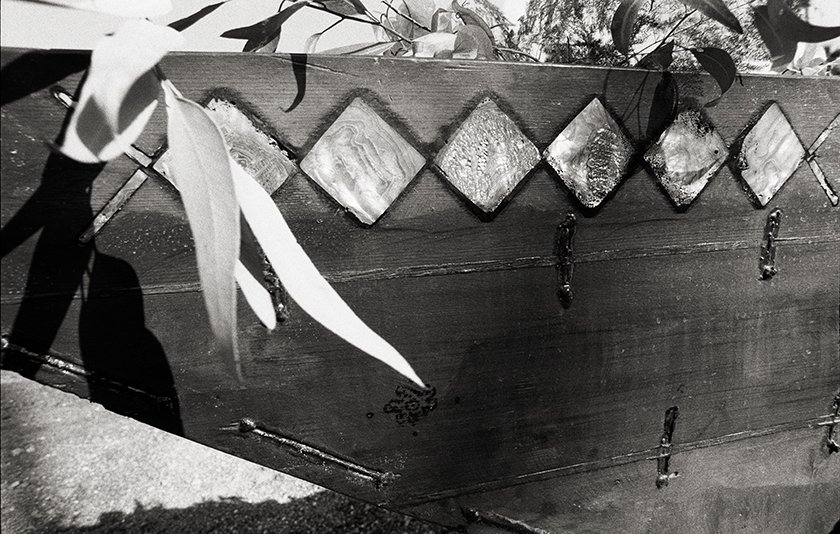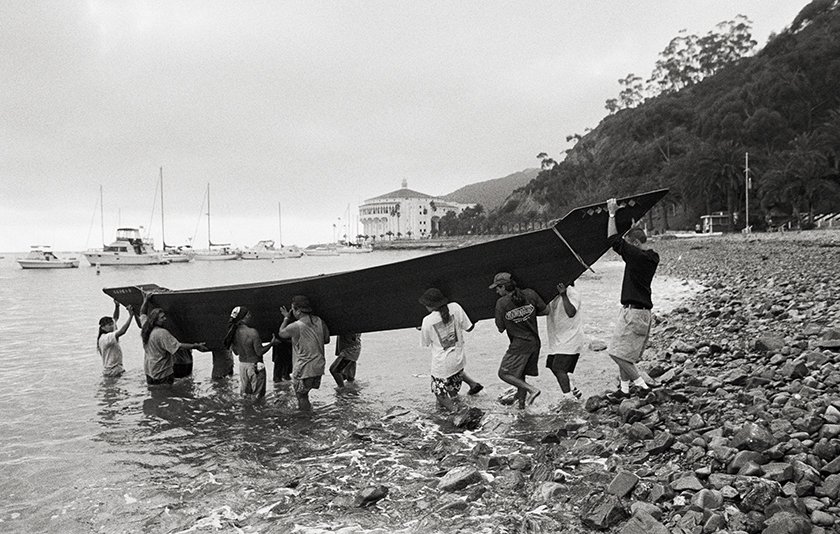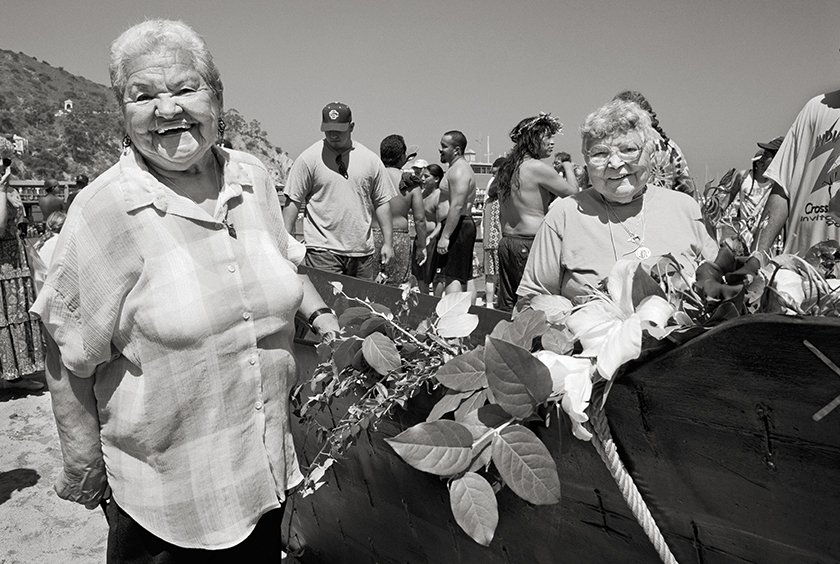Launching a Dream
Reviving Tongva Maritime Traditions
Mo’omaht Ahiko (A Tongva ti’at) and ‘Elye’wun (a Chumash tomol), off the coast of Pimu (
Catalina Island), San Pedro Channel, 1998
“The ti’atem came in my Dreamtime years ago. We were gifted by an ancestral warrior, buried from his shoulders down, in the Santa Ana Mountains. As he opened his enormous eyes the earth began to shift. Before us was a massive lake with plank-canoes filled with our people. As we began to paddle in sync the mountains separated, the ocean lifted the ti’atem, and there was Catalina Island. We were headed home.”
—Cindi Alvitre, Moompetam (Salt Water People)
In September 1996, for the first time in over two hundred years, the Tongva community launched a Southern California Indian sewn plank canoe (ti’at) into the channel waters off Santa Catalina Island. A crew of five paddlers guided the vessel, named Mo’omat Ahiko (Breath of the Ocean), twelve miles along the rugged coastline of the sacred island known to them as Pimu.
The Tongva community’s effort to revitalize its maritime traditions emerges from a nightmarish history. Since the Spanish colonization of California, the original inhabitants of the Los Angeles basin and the southern Channel Islands have experienced severe depopulation, loss of land, and cultural fragmentation. In this context, plank canoes (ti’atem) serve not only as distinctive markers of identity but also represent renewed connections to the ocean and the ancestors.
Not long after Cindi Alvitre had dreamt of an awakening warrior and tia’tem filled with homeward-bound Tongva peoples, she was contacted by kayak expert Jim Noyes who offered to fund the creation of Mo’omat Ahiko. Peter Howorth, a boat builder familiar with Chumash canoe (tomol) design, soon joined the effort to rejuvenate a nearly vanished tradition. Two previously existing Chumash vessels served as models: the tomol constructed by Fernando Librado in 1912 and the Helek (Hawk) constructed in 1976, both now housed in the Santa Barbara Museum of Natural History.
Following the appearance in 1996 of the ti’at Mo’omat Ahiko and its counterpart tomol named ‘Elye’wun (Swordfish) in 1997, the Tongva and Chumash have enjoyed a renaissance of their traditional ocean-faring culture that places the vessels at the center of communal gatherings and ritual activities including “village hops” where the canoes are paddled to important cultural sites along the coast, and annually across the channel.
Photographers Frank Magallanes and Althea Edwards began charting the renewal of Southern California Native maritime navigation in 1996. Selected from a larger series of photographs of the Tongva and Chumash plank-canoes, the images here highlight the role of Mo’omat Ahiko in Tongva cultural perseverance and community engagement.
We invite you to look not only here but beyond as this dream continues on, within and all around us, propelled by many more hands and through future generations…
Text and images from the 2011 exhibit “Launching A Dream: Reviving Tongva Maritime Traditions” at the Fowler Museum, UCLA. Curated by Dr. Wendy Teeter and Cindi Alvitre.
Honuukvetam (Dreamtime)




Left to right 1: Mo’omaht Ahiko paddlers (Burt Barlow, Pastor Lopez, Rick Mendez, Marcus Lopez) Avalon, Catalina Island, 1997. 2: Ceremonial drumming for ti’at paddlers, Avalon, Catalina Island, 1996. 3: Detail of abalone design and inlay by L. Frank, Avalon, Catalina Island, 1996. 4: Mo’omaht Ahiko being carried to shoreline, Avalon, Catalina Island, 1997. 5: Ti’at paddling past Long Point, Catalina Island, 1998
Eyoo’ma’maan (Creation)




Left to right 1: Marcus Lopez and Luis Ramirez seal the lashings on the Chumash tomol ‘Elye’wun, Santa Barbara, 1997. 2: John Moreno applies sealant to paddles, Montecito, 1997. 3: Detail of an a’koton (ceremonial skirt), Rancho Cucamonga, 2005. 4: Cindy Dorame weaving an a’koton, Montecito, 1997. 5: Dominic Robles shaping a new paddle blade, Covina, 2009. 6: Captain Marcus Lopez repairing top plank on Mo’omaht Ahiko, Montecito, 1997. 7: Cousins River Garza and Javier Arias recoating Mo’omaht Ahiko with sealant, Montecito, 1997.


Ohat (Ballasting and Preparation)




Left to right 1: Filling sand bags for ballast, Avalon, Catalina island, 1997. 2: Ballast at the ready, Avalon, Catalina Island, 1997. 3: Perry Cabugos setting ballast in the tomol, Malibu, 2001. 4: Ready to journey, Santa Monica Beach, 2005. 5: Sending out, Santa Monica Beach, 2005.
Ahooyawpe’ (Journey)
Mo’omaht Ahiko pulling water, Santa Monica Beach, 2008
Mo’omaht Ahiko pulling past the casino at Avalon, Catalina Island, 1997


Left to right 1: Changing paddlers, Catalina Island coast, 1998. 2: Renewal and reflection, ‘Elye’wun at Anacapa arch, Anacapa Island, 2001.
‘Elye’wun in Long Beach Harbor, 2008.
Yamon Hene (Coming Home)
Ocean of Boats, Avalon, Catalina Island, 1997




Left to right 1: Riding the surf, Santa Monica Beach, 2008. 2: Children welcoming Mo’omaht Ahiko, Avalon, Catalina Island, 1996. 3: Arrival in Avalon Harbor, Catalina Island, 1997. 4: Mo’omaht Ahiko and ‘Elye’wun honoring the people on Pimu, Avalon, Catalina Island, 1998.
Kehaay (Celebration)




Left to right. 1. Hawaiian dancers carrying Mo’omaht Ahiko, Santa Monica Beach, 2005. 2. Future generations (Dominic Robles, Jimmy Mendez, Ricky Mendez). 3. The embrace, Avalon, Catalina island, 1996. 4. Bringing in the paddles (Gabriel Robles) Avalon, Catalina Island, 1996.
Community support, Santa Monica Beach, 2008
Eweenax’wee’ooxra (Honoring)



Clockwise from top left 1. Who the hell is Mo’omaht Ahiko? Santa Monica, 2011. 2. Lillian Robles at Pu’uvungna, California State University, Long Beach, 2000 3. Chumash elders (Grandma Liz and Grandma Stella), Avalon, Catalina Island, 1996
Two sisters, ‘Elye’wun and Mo’omaht Ahiko, Long Beach, 2006












